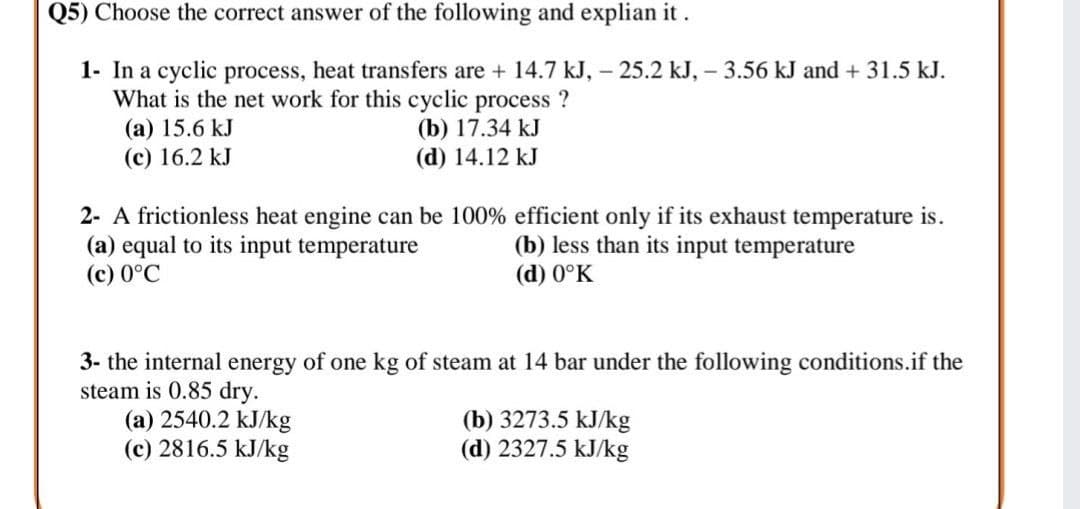Q5) Choose the correct answer of the following and explian it . 1- In a cyclic process, heat transfers are + 14.7 kJ, – 25.2 kJ, – 3.56 kJ and + 31.5 kJ. What is the net work for this cyclic process ? (a) 15.6 kJ (c) 16.2 kJ (b) 17.34 kJ (d) 14.12 kJ 2- A frictionless heat engine can be 100% efficient only if its exhaust temperature is. (a) equal to its input temperature (c) 0°C (b) less than its input temperature (d) 0°K 3- the internal energy of one kg of steam at 14 bar under the following conditions.if the steam is 0.85 dry. (a) 2540.2 kJ/kg (c) 2816.5 kJ/kg (b) 3273.5 kJ/kg (d) 2327.5 kJ/kg
Q5) Choose the correct answer of the following and explian it . 1- In a cyclic process, heat transfers are + 14.7 kJ, – 25.2 kJ, – 3.56 kJ and + 31.5 kJ. What is the net work for this cyclic process ? (a) 15.6 kJ (c) 16.2 kJ (b) 17.34 kJ (d) 14.12 kJ 2- A frictionless heat engine can be 100% efficient only if its exhaust temperature is. (a) equal to its input temperature (c) 0°C (b) less than its input temperature (d) 0°K 3- the internal energy of one kg of steam at 14 bar under the following conditions.if the steam is 0.85 dry. (a) 2540.2 kJ/kg (c) 2816.5 kJ/kg (b) 3273.5 kJ/kg (d) 2327.5 kJ/kg
Elements Of Electromagnetics
7th Edition
ISBN:9780190698614
Author:Sadiku, Matthew N. O.
Publisher:Sadiku, Matthew N. O.
ChapterMA: Math Assessment
Section: Chapter Questions
Problem 1.1MA
Related questions
Question
I need it within half an hour

Transcribed Image Text:Q5) Choose the correct answer of the following and explian it.
1- In a cyclic process, heat transfers are + 14.7 kJ, – 25.2 kJ, - 3.56 kJ and + 31.5 kJ.
What is the net work for this cyclic process ?
(a) 15.6 kJ
(c) 16.2 kJ
(b) 17.34 kJ
(d) 14.12 kJ
2- A frictionless heat engine can be 100% efficient only if its exhaust temperature is.
(a) equal to its input temperature
(c) 0°C
(b) less than its input temperature
(d) 0°K
3- the internal energy of one kg of steam at 14 bar under the following conditions.if the
steam is 0.85 dry.
(a) 2540.2 kJ/kg
(c) 2816.5 kJ/kg
(b) 3273.5 kJ/kg
(d) 2327.5 kJ/kg
Expert Solution
This question has been solved!
Explore an expertly crafted, step-by-step solution for a thorough understanding of key concepts.
This is a popular solution!
Trending now
This is a popular solution!
Step by step
Solved in 3 steps

Knowledge Booster
Learn more about
Need a deep-dive on the concept behind this application? Look no further. Learn more about this topic, mechanical-engineering and related others by exploring similar questions and additional content below.Recommended textbooks for you

Elements Of Electromagnetics
Mechanical Engineering
ISBN:
9780190698614
Author:
Sadiku, Matthew N. O.
Publisher:
Oxford University Press

Mechanics of Materials (10th Edition)
Mechanical Engineering
ISBN:
9780134319650
Author:
Russell C. Hibbeler
Publisher:
PEARSON

Thermodynamics: An Engineering Approach
Mechanical Engineering
ISBN:
9781259822674
Author:
Yunus A. Cengel Dr., Michael A. Boles
Publisher:
McGraw-Hill Education

Elements Of Electromagnetics
Mechanical Engineering
ISBN:
9780190698614
Author:
Sadiku, Matthew N. O.
Publisher:
Oxford University Press

Mechanics of Materials (10th Edition)
Mechanical Engineering
ISBN:
9780134319650
Author:
Russell C. Hibbeler
Publisher:
PEARSON

Thermodynamics: An Engineering Approach
Mechanical Engineering
ISBN:
9781259822674
Author:
Yunus A. Cengel Dr., Michael A. Boles
Publisher:
McGraw-Hill Education

Control Systems Engineering
Mechanical Engineering
ISBN:
9781118170519
Author:
Norman S. Nise
Publisher:
WILEY

Mechanics of Materials (MindTap Course List)
Mechanical Engineering
ISBN:
9781337093347
Author:
Barry J. Goodno, James M. Gere
Publisher:
Cengage Learning

Engineering Mechanics: Statics
Mechanical Engineering
ISBN:
9781118807330
Author:
James L. Meriam, L. G. Kraige, J. N. Bolton
Publisher:
WILEY